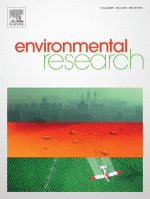Ver ítem
- xmlui.general.dspace_homeCentros e Institutos de InvestigaciónCIRN. Centro de Investigaciones de Recursos NaturalesInstituto de Recursos BiológicosArtículos científicosxmlui.ArtifactBrowser.ItemViewer.trail
- Inicio
- Centros e Institutos de Investigación
- CIRN. Centro de Investigaciones de Recursos Naturales
- Instituto de Recursos Biológicos
- Artículos científicos
- Ver ítem
Concentration of current-use pesticides in frogs from the Pampa region and correlation of a mixture toxicity index with biological effects
Resumen
Contamination with current-use pesticides is frequently mentioned as a key factor in global amphibian declines although a limited number of studies have examined the mixture of pesticides accumulated by free-living frogs. This study examined the presence of 46 different pesticide residues in the muscle and kidney tissues of two frog species living in close association with row crops in the Pampa region of Argentina: The terrestrial Leptodactylus latinasus
[ver mas...]
Contamination with current-use pesticides is frequently mentioned as a key factor in global amphibian declines although a limited number of studies have examined the mixture of pesticides accumulated by free-living frogs. This study examined the presence of 46 different pesticide residues in the muscle and kidney tissues of two frog species living in close association with row crops in the Pampa region of Argentina: The terrestrial Leptodactylus latinasus and the semi-aquatic Leptodactylus latrans. A total of 20 different pesticides were identified in frog tissues; chlorpyrifos-methyl, pirimiphos-methyl and acetochlor being the most frequently detected molecules. Overall, one or more pesticide residues (up to 12 in a single frog) were detected in 40–57 % of L. latrans. L. latinasus was found to present more pesticide detections than L. latrans. Interestingly, frog sampled in a natural reserve where no pesticides are applied presented an equivalent frequency of detections as frogs living near a crop. In L. latrans, the calculation of a pesticide toxicity index (PTI) permitted to highlight the existence of a strong positive correlation between PTI and liver GSH contents of females whereas, in males, PTI was negatively correlated with the perimeter of testicular seminiferous tubules. Males also presented near significant negative correlations between PTI and both body condition and the scaled fat index. These results indicate that frogs inhabiting agricultural regions are exposed to a complex and diffuse contamination by pesticide mixtures which is likely responsible for a number of biological effects that may be relevant at the population level.
[Cerrar]

Fuente
Environmental Research 204 (Part D) : 112354. (March 2022)
Fecha
2021-11
Editorial
Elsevier
ISSN
0013-9351
Documentos Relacionados
Formato
pdf
Tipo de documento
artículo
Proyectos
(ver más)
INTA/PNNAT-1128043/AR./Los agroquímicos como fuente de contaminación difusa en agroecosistemas.
INTA/2019-PE-E2-I054-001/2019-PE-E2-I054-001/AR./Gestión sostenible de fitosanitarios
Palabras Claves
Derechos de acceso
Restringido
 Excepto donde se diga explicitamente, este item se publica bajo la siguiente descripción: Creative Commons Attribution-NonCommercial-ShareAlike 2.5 Unported (CC BY-NC-SA 2.5)
Excepto donde se diga explicitamente, este item se publica bajo la siguiente descripción: Creative Commons Attribution-NonCommercial-ShareAlike 2.5 Unported (CC BY-NC-SA 2.5)

